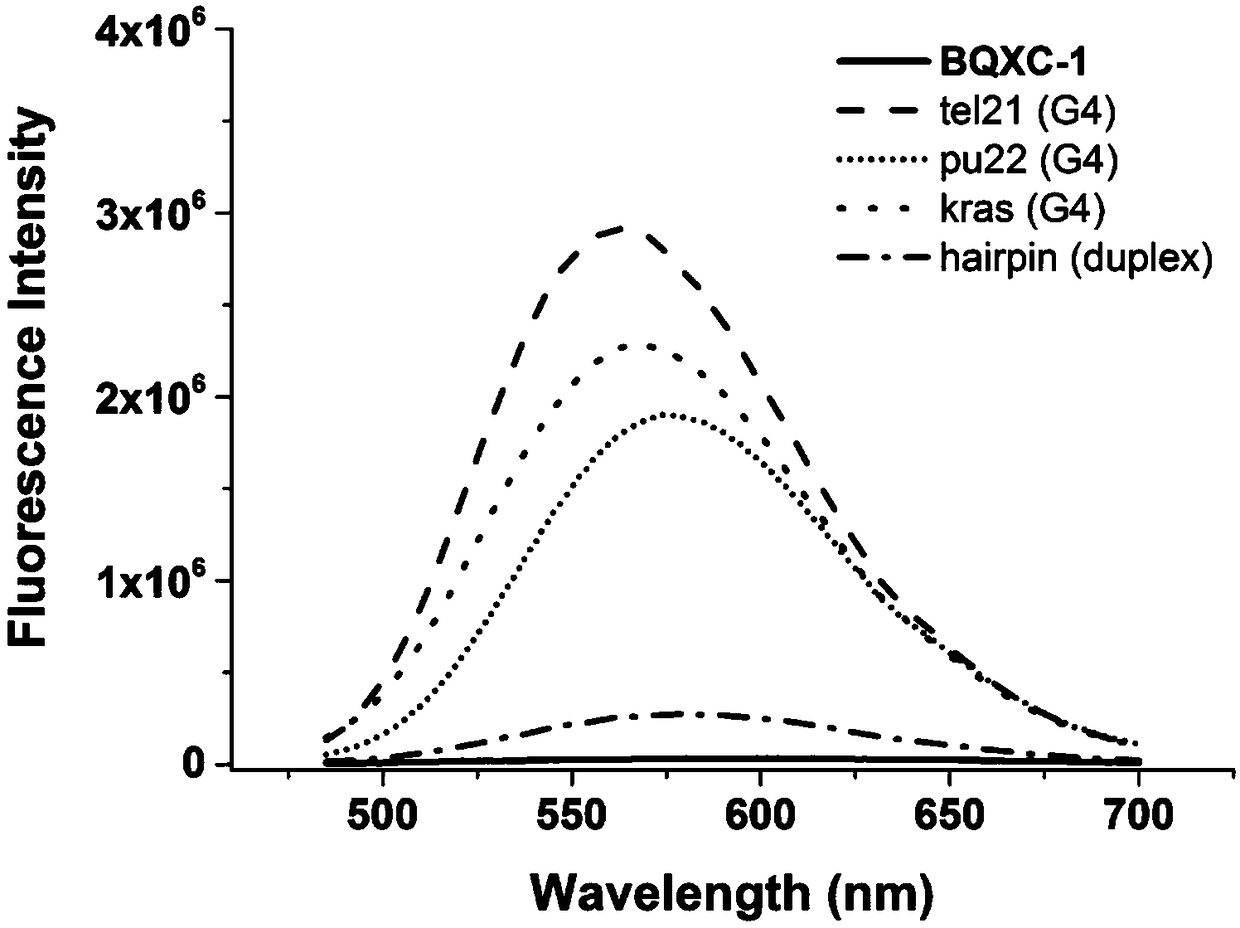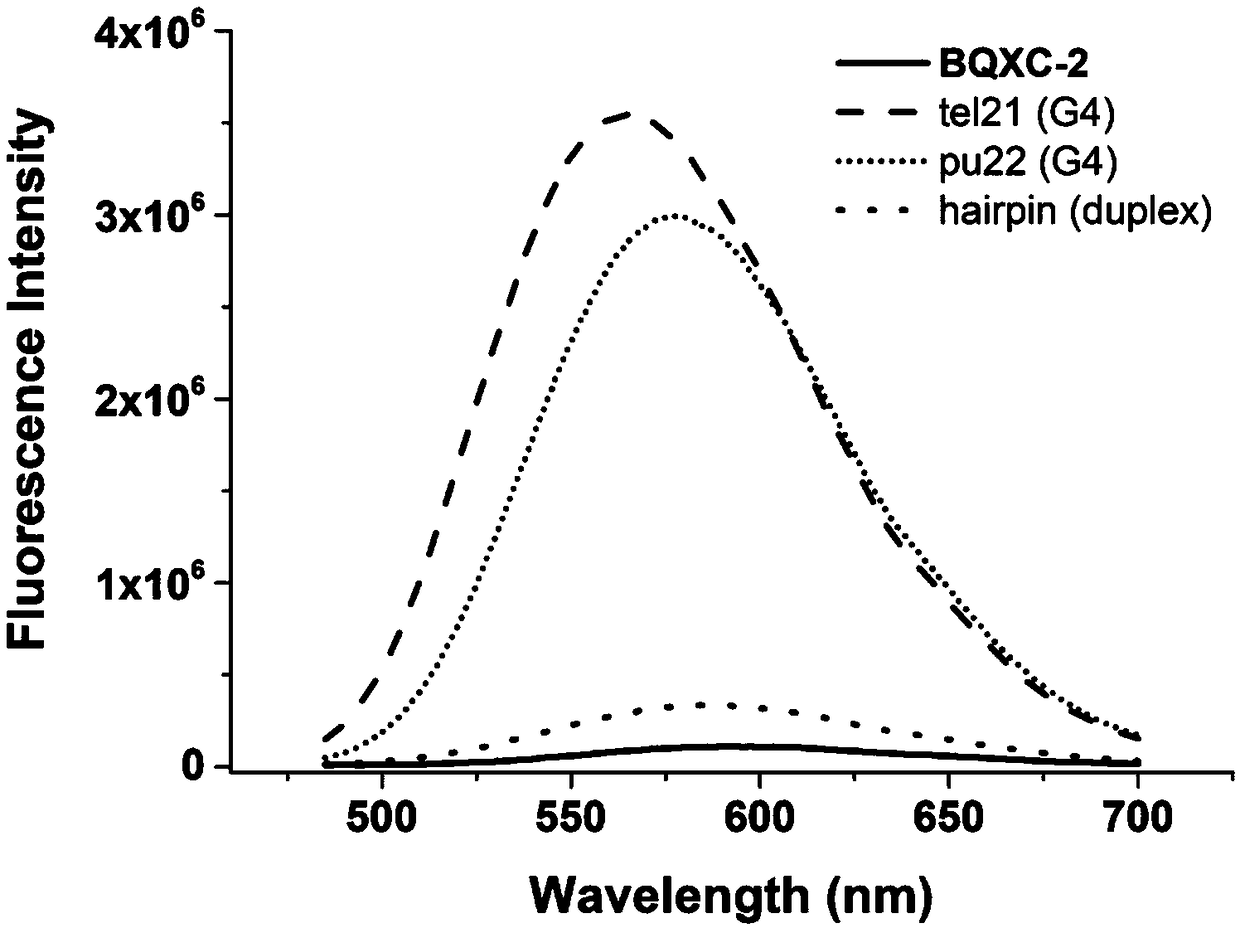Preparation method of quinoxaline type fluorescent probe and application of quinoxaline type fluorescent probe in detection of G-quadruplex
A technology of fluorescent probes and quadruplexes, applied in fluorescence/phosphorescence, chemical instruments and methods, luminescent materials, etc., to achieve low cost, stable structure, and simple preparation
- Summary
- Abstract
- Description
- Claims
- Application Information
AI Technical Summary
Problems solved by technology
Method used
Image
Examples
Embodiment 1
[0035] Embodiment 1: the synthesis of compound 2
[0036] Dissolve the raw material 3,6-dibromo-9,10-phenanthrenequinone in 20mL DMSO (2.0g), add 5 times the molar equivalent of N-methylpiperazine and 1 times the molar equivalent of K2CO3, in an oil bath at 90°C After heating and reacting for 24 hours, the reaction solution was poured into 200 mL of ice water, a large amount of solids were precipitated, filtered under reduced pressure, and dried in vacuo to obtain a purple solid with a yield of 80%. Mass spectrometry confirmed the structure. MS(ESI)m / z405.2[M+H]+.
Embodiment 2
[0037] Embodiment 2: the synthesis of compound 3 (BQX-1)
[0038] Disperse compound 2 in 100mL ethanol (1.0g), add 2 times the molar equivalent of 4,5-difluoro-o-phenylenediamine, add 5 drops of glacial acetic acid as a catalyst to the reaction system, and reflux for 20 hours; after the reaction, After natural cooling, solids were precipitated, vacuum filtration under reduced pressure, and the filter cake was washed 3 times with a small amount of ethanol to obtain a brownish-yellow solid with a yield of about 60%. 1H NMR (500MHz, CDCl3) δ9.11 (d, J = 8.8Hz, 2H), 7.93 (t, J = 9.5Hz, 2H), 7.87–7.77 (m, 2H), 7.37–7.30 (m, 2H) ,3.66–3.49(m,8H),2.95–2.71(m,8H),2.50(s,6H).13C NMR(126MHz,CDCl3)δ152.50,151.83,142.09,138.48,133.15,127.40,122.02,116.73,113.71 ,107.21,77.37,77.11,76.86,54.75,48.04,45.77.MS(ESI)m / z 513.3[M+H]+.
Embodiment 3
[0039] Embodiment 3: the synthesis of compound BQX-2
[0040] Compound 3 (BQX-1) was dissolved in 10 mL of DMF (0.5 g), and 5 molar equivalents of N-methylpiperazine and 1 molar equivalent of K 2 CO 3, heated and reacted in an oil bath at 80°C for 24h, then poured into ice water, solids were precipitated, filtered under reduced pressure, and dried in vacuo. Then it was separated by column chromatography, and the eluent was dichloromethane / methanol (volume ratio 30:1) to obtain a yellow solid with a yield of about 50%. 1H NMR (500MHz, CDCl3) δ9.14(d, J=6.1Hz, 2H), 7.87–7.74(m, 3H), 7.61(d, J=8.5Hz, 1H), 7.35(d, J=8.2Hz ,2H),3.60–3.47(m,8H),3.47–3.35(m,4H),2.86–2.71(m,12H),2.48(s,9H).13C NMR(126MHz,CDCl3)δ157.46,152.30,152.21 ,143.14,141.64,140.83,139.98,138.44,133.03,132.81,127.23,127.16,122.90,122.86,117.11,117.04,114.96,112.70,107.58,107.55,77.34,77.08,76.83,54.88,50.23,48.42,48.38,45.91 ,45.88.MS(ESI)m / z 593.3[M+H]+.
PUM
 Login to View More
Login to View More Abstract
Description
Claims
Application Information
 Login to View More
Login to View More - R&D
- Intellectual Property
- Life Sciences
- Materials
- Tech Scout
- Unparalleled Data Quality
- Higher Quality Content
- 60% Fewer Hallucinations
Browse by: Latest US Patents, China's latest patents, Technical Efficacy Thesaurus, Application Domain, Technology Topic, Popular Technical Reports.
© 2025 PatSnap. All rights reserved.Legal|Privacy policy|Modern Slavery Act Transparency Statement|Sitemap|About US| Contact US: help@patsnap.com



